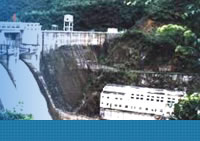Wu Lianchun Zheng Minsheng
(Senior Engineers from Xiaolangdi Multipurpose Dam Project Construction and Management Bureau, Ministry of Water Resources, Zhengzhou, Henan, 450000)
Xiaolangdi reservoir dam is located in the last gorge of the middle reach of the world famous sandy Yellow River, which controls 91.2% of runoff and 100% of sand. During initial operation of the reservoir, sediment reduction was realized mainly through density flow. By proportional selection along the rive course of Xiaolangdi reservoir, “retaining coarse sand and dewatering fine sand” is achieved, thus the reservoir’s efficiency of sediment reduction is enhanced and its service life is extended. Since the fine sand is easily flushed to the ocean and is controllable through the down stream river course of the Yellow River, the density flow from Xiaolangdi reservoir will not exacerbate sedimentation of the down stream river slot. This paper analyzes the survey data on Xiaolangdi reservoir’s density flow, summarizes variation characteristics and inherent relations among the density flow’s thickness, speed, sand content and particle gradation, explores the density flow’s formation, principle of movement, keeping conditions and affecting factors, gives suggests on how to make good use density flow to control reservoir sedimentation.
I. Brief introduction on Xiaolangdi Multipurpose Dam Project
Xiaolangdi dam is located at the last gorge of the middle reach of the Yellow River, 130Km upstream of Sanmenxia dam, 128Km downstream of Zhengzhou huayuankou. It is a key project to control the Yellow River’s sedimentation. The storage capacity of Xiaolangdi reservoir is 12.65 billion cubic meters, of which, long term live capacity is 5.1 billion cubic meters. The reservoir controls the Yellow Rier by 694.200 Km2, 92.3% of the total, controls cutoff by 91.2% and sand by 100%. Xiaolangdi project is a a much more important item in the overall planning for harnessing the Yellow River, which is nominant in flood control, ice jam prevention and sediment reduction, with also consideration of water supply, irrigation and power generation, hence it is a comprehensive benefit project, emiminating the harmful and developing the useful.
Xiaolangdi dam is a rockfill dam with an inclined clay core wall, which is 160m high, 1667m long. There are in total 6 power units with the toal installed capacity of 1800MW (300MW per unit). The flood discharging system is consist of 9 discharge tunnels, including 3 orifice tunnels, 3 sediment tunnels, 3 free flow tunnels and 1 service spillway, which can discharge flow at 14,733m3/s in maximum.
Xiaolangdi reservoir’s normal service level is El.275m, thus the structures for flow discharge are laid out according to “lower level for sediment control, higher level for sewage dewatering, middle level for power generation”. The lower sediment tunnels and orifice tunnles’ intakes are at El.175m. The reservoir can discharge at 4810m3/s while it is at El.210m of the lowest service level, which makes density flow easiliy out from the reservoir, realizing “retaining the coarse and dewatering the fine sand”, hence extending the service life ofreseroir and reducing deposit of the downstream
II. Situation of sand flushing through density flow from Xiaolangdi reservoir
The main stream of Xiaolangdi reservoir is a a kind of deep vally river. The natural river course on static condition is 150m to 500m wide. In genral, such section of river is narrow u/s and wide d/s with big gradient of rapid flow and water fall. The reservoir lies in mountain area, full of earth and rock, gullies and branch streams. There are 50 different sized branch streams, short in length and big in gradient. The volume of branch streams stand 42.2% of the total.
Reservoir density flow is a special flow with high content of sand. Such flow will dive beneath clear water due to density differences and form a stream of muddy water, keep progressing to the front of the dam. It is a main way for Xiaolangdi reservoir to retain sand through density flow.
During 8 years since Xiaolangdi reservoir was put into operation in early 2000, there are in total 2.973 billion- t-inflowing sand and 547 million-t-outflowing sand, 18.4% of sand flushing in average. All the sand was flushed out through density flow.
Sand was flushed out through density flow from Xiaolangdi reservoir, meanwhile, the Yellow River d/s river slot was flushed completely with increased capacity of flow release. A certain section, used to be hard to release, could discharge 1800m3/s in July 2002 while 3720m3/s in 2007.
III. Analysis on movement principle of Xiaolangdi reservoir density flow
1、 Arrangement of survey profiles in the reservoir
There are in total 9 profiles, 4 of which are HH01(Tongshuling), HH09, HH29 and HH37(river dike); the 5 others are auxiliary ones, which are profiles in front of the dam ( 410m away from the dam), HH05, HH13, HH17, Sunxi estuary and the profile in the downstream of the diving point ( see figure 1).
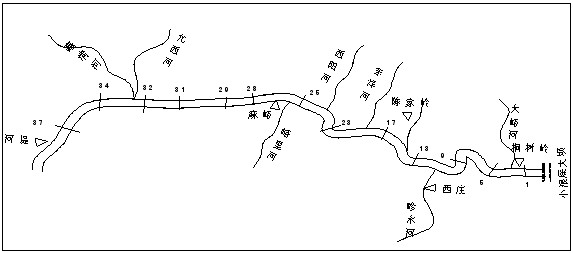
II)Analysis on data
The data, measured during Xiaolangdi flow-sand regulation event which happened in late of June 2007, were introduced to analyze the general characteristics of Xiaolangdi density flow movement.
Xiaolangdi reservoir level is El.244.77m when the flow-sand regulation event started on June 19, 2007, while El.231.08m on forming density flow on June 27 and El.223.63m in completion of the event ( see figure 2).
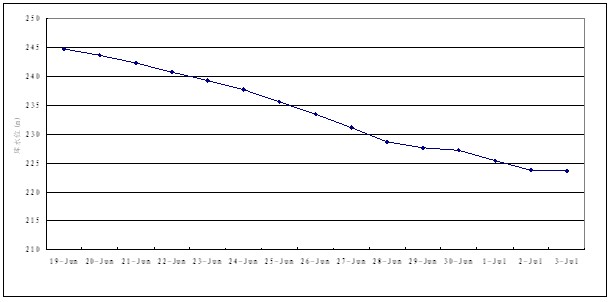
1)Changes of density flow diving point
During the density flow formation, the diving points were variable, firstly at profile HH19, 1200m d/s ( 31.85Km from the dam) found on June 27 18:30p.m. and later at profile HH17, 400m d/s ( 27.19Km away from the dam ) on June 27 19:30, at profile HH15 ( 24.43Km away from the dam) on June 28, which showed that the diving points moved to the d/s with decrease of the reservoir revel and increase of sand inflow from the upstream.
2)transveral distribution of density flow’s speeds, sand contents and median particles diameter D50
At the d/s profile of the diving point, with initial diving of the density flow, less dynamic energy was consumed in the process and the average speed of density flow layer was bigger. Seen from profile HH17 (figure 3), there are big changes in average speeds, 1.7m/s in maximum and 0.1m/s in minimum. The main stream moved fast with more sand while the side strea, was the other case, which was similar with natural river course.
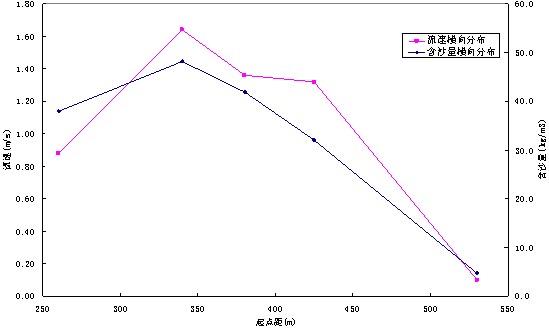
The transversal distributions are similar regarding the average sand content in profiles HH15, HH17 and D50. In main slot, there are more sand and coarser sand, and also in sectional direction, the sizes of particles are extremely different. Figure 4 shows the transversal distribution of sand content in profile HH17 and D50.
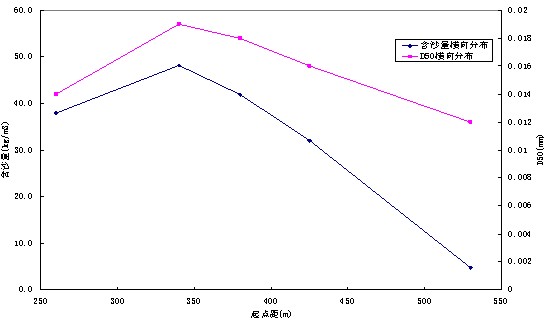
3).Longitudinal evolution of density flow
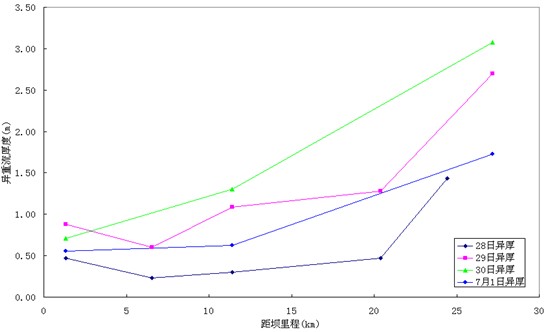
Figure 5 shows the changes of density flow in Xiaolangdi reservoir from June 28 to July1, i.e. the depth of density flow became thinner and thinner. Beween June 28 and 29, the density flow at profile HH01 ( 1.32Km away from the dam) was thicker than that at profile HH05 (6.54Km away from the dam), due to more inflow sand than outflow one, which caused higher level of density flow in front of the dam.
Changes of speed are similar to those of sand content and thickness of density flow. With slower movement, the sand in density flow became less and deposition occurred along the river course.
Among coefficients which describe density flow movement, i.e. thickness, speed, sand content and gradation, speed is the leading factor, which decides density flow’s sand flushing capacity. Faster density flow brings more and coarser sand.
What’s more, volume of inflow has big impact on density flow’s evolution. The most strengthful density flow occurred at different profiles on June 29 and 30 after Sanmenxia reservoir discharged extremely sandy water to Xiaolangdi reservoir. On July1, density flow turned less powerful with decease in inflow and sand.
3、Stagnation conditions of water and sand to keep density flow progressing to the front of the dam
Sand flushing through density flow of Xiaolangdi reservoir shows universality and particularity, for the latter, it includes regulation of Sanmenxia reservoir, complicated reservoir terrain resulting in local loss of density flow energy. In a couple of branch streams in Xiaolangdi reservoir, usually density flow will progress back to the branch streams.
Upon analysis on years’ data of density flow, in connection with relevant test results, Yellow River Conservancy Committee (YRCC) studied the basic principles on start, operation and sand flushing of density flow.
As for flow/sand conditions for density flow to progress to the front of Xiaolangdi dam, except for enough time for flood release, certain flow and sand content should be met, for the energy of density flow due to flood release should balance the energy losses in relation to density flow movement.
Zone A is the area where density flow will move to the front of the dam. As for the marginal conditions ( the left bottom line ), except for enough time of floods and 50% of fine sand, enough big flow and sand content should be included, i.e. first, more than 2000m3/s of inflow with more than 40Kg/m3 of sand; second, 500m3/s to 2000m3/s of inflow with S>280-3Q/25(S:sand, Kg/m3;Q:inflow, m3/s).

Zone B is the area where density flow may or may not move to the front of the dam, for the former situation, three conditions should be met: first, when floods turned less powerful, density flow’s resistance is less than its head’s, for density flow head needs more strength to keep away its front clear water; second, even though the sand with inflow is less, the sections get flushed between the reservoir’s intake and tail of back water, resulting in more content of sand at the diving profile of density flow; third, the fine sand with inflow stands 75% of the total.
Zone C is the area where density flow will not move to the front of the dam, for the inflow speed is less than 500m3/s or sand content is less than 40kg/m3.
IV. Suggests on how to make good use density flow to control Xiaolangdi reservoir sedimentation
Under certain marginal condition of reservoir, enough energy and time should be met in order to keep density flow progressing and obtain ideal sand flushing effects. The density flow’s energy is subject to the flow-sand conditions, say, more inflow and more sand ( especially fine sand ), more energy and more initial speed; the density flow’s marching time will be decided by floods with high sand content, i.e., shorter time floods, shorter time sand flushing. In case of less inflow, density flow will lose energy and stop or disappear shortly.
According to the conditions of inflowing water and sand, different manners are adopted for reservoir dispatch to realize less and reasonable sedimentation.
1. In time of floods in the middle reach of the Yellow River, make good use of natural floods for sand flushing
There usually occurred floods with high content of sand in the middle reach of the Yellow river, normally the content of fine sand is higher, however it will be much higher after regulation of Sanmenxia reservoir. In the process of reservoir dispatch, Sanmenxia reservoir should be used adequately in order to provide Xiaolangdi reservoir conditions to form density flow and flush more sand out of the reservoir.
1)Regulate Sanmenxia reservoir to control sand in Zone A to raise density flow’s sand content in Xiaolangdi reservoir and extend sand flushing time as possible.
2)Operate Xiaolangdi tunnels reasonably at different levels. Before and after density flow reaches the dam, lower tunnels are used firstly and higher ones followed if necessary, i.e. sediment tunnels first and free flow tunnels followed if needed.
2. In time of non-floods in the middle reach of the Yellow River, jointly regulate Wanjiazai reservoir, Sanmenxia reservoir and Xiaolangdi reservoir to form artificial density flow for sand flushing from Xiaolangdi reservoir
In time of non-floods in the middle reach of the Yellow River, jointly regulate Wanjiazai, Sanmenxia and Xiaolangdi reservoirs, make good use of the water above flood limit of Wanjiazai and Sanmenxia reservoirs with support of the nature, thus, sand is flushed out and reservoir tail sedimentation is improved.
In order to form artificial density flow and keep it moving to the front of the dam, the process of forming density flow should meet the requirements of continuous movement. The inflow should bring enough fine sand, and the artificial floods provide more energy than losses consumed in the process, otherwise, density flow will disappear.
1) Sources of flow and sand of density flow in Xiaolangdi reservoir
The sand, esp. the fine sand content in density flow is the key factor for sand flushing. There are 2 sources of sand to form density flow in Xiaolangdi reservoir, one is in Xiaolangdi delta at the tail of the reservoir ( less fine sand content), which need to be flushed suspended through high discharge from Sanmenxia reservoir; the other source is in deep slot of Sanmenxia reservoir, which need to be flushed out at the reservoir’s lower or bottom level with support of Wanjiazai reservoir.
2)Outflow from Sanmenxia reservoir
Sanmenxia reservoir should discharge enough powerful flow to flush the sedimentation delta at the tail of Xiaolangdi reservoir, thus density flow will appear and progress continuously. In general conditions, Sanmenxia reservoir should discharge out not less than 2000m3/s with certain time span.
3) Making good use of Wanjiazai reservoir as possible
To form density flow in reservoir for sand flushing needs a certain flow and time span, and also enough fine sand content. Therefore, how many volumes and what time to discharge from Wanjiazai and Sanmenxia reservoirs need to be defined to assure of successive discharge and enough sand stirred and flushed by the discharging flow. In general, Wanjiazai reservoir should discharge not less than 1000m3/s for at least 2 days.
4) The main way to flush more sand is that we form density flow while Xiaolangdi reservoir level is low, in order to shorten its moving distance, reduce energy loss and raise its capacity to flush sand. While choosing reservoir levels for forming density flow, such factors should be considered comprehensively as inflow, reservoir volume consumption for sand flushing, sediment reduction of the d/s river course and water supply to the d/s, etc. In general, it is better to form density flow while reservoir levels are betweem El.226m and El.230m.
Note: The measuring data mentioned in this paper are provided by Yellow River Hydrology and Water Resources Scientific Research Institute

